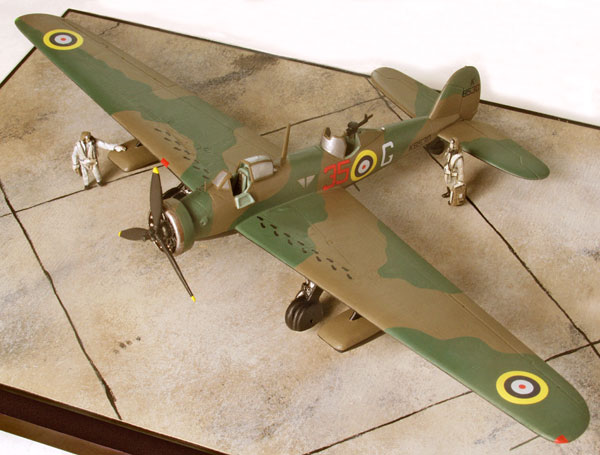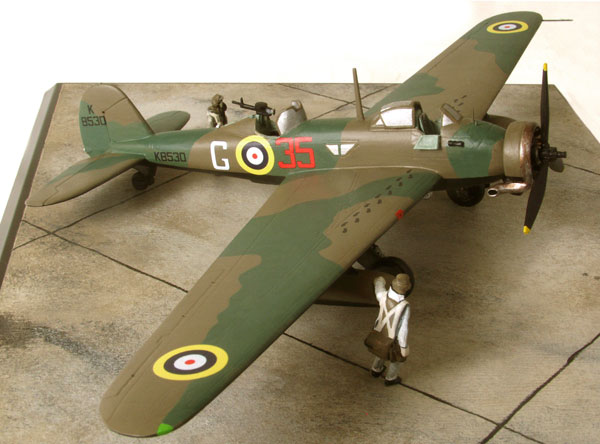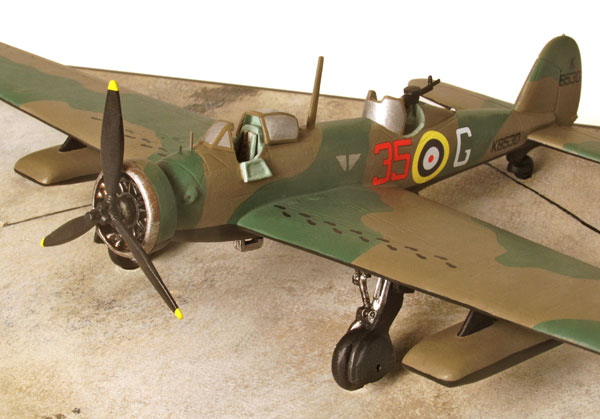Vickers Wellesley Mk I
Vickers Wellesley Mk I K8530 35-G
35 Squadron, RAF Worthy Down, 1938.
The Vickers Wellesley Mk I was one of those aircraft that, although built in limited numbers, had an influence both on design and on operations. It was designed as Vickers Type 246 to meet Air Ministry Specification G.4/31 for a General Purpose aircraft, a category of which the RAF made considerable use, but was not one of the nine submissions were selected to be built as prototypes for testing; of the three designs, two biplanes and a monoplane, submitted by Vickers the Ministry chose their Type 253 biplane for the trial. The winner of the trial, the Westland PV-7 high-wing monoplane subsequently had a structural problem with its wing that resulted in the loss of the prototype, and Vickers were awarded a production order for 150 aircraft for their Type 253 biplane.
The fuselage of the Type 253 was built with a “geodetic”, lattice-like, structure. This had been used in the building of the Vickers-built R.101 airship, but after the loss of the R.100 airship building in Britain ceased; Barnes Wallis, one of its design team, joined Vickers (Aviation) at Weybridge as Designer (Structures) and saw the introduction of this form of construction for aircraft. Used for the fuselage of the biplane Type 253, for the monoplane Type 246 it was also used for the flying surfaces. In spite of the Air Ministry’s selection of the biplane the Vickers management was so convinced of the superiority of their monoplane that they decided in April 1932 to continue with it as a private venture – it cost Vickers £30,271 – and its prototype made its first flight on 19 June 1935, flying again on the following day with Barnes Wallis as passenger. Three months testing convinced the Air Ministry of its superiority over the biplane and in September the order for the Type 253 was changed for one for 79 of the monoplane.
The prototype 246 was bought by the Air Ministry, and following further trials and tests changes were made; the manually retracted undercarriage was now hydraulically operated, an up-rated Pegasus was fitted and the cockpits of both pilot and gunner were given transparent canopies. The problem of breaking the geodetic structure to accommodate a bomb bay was avoided by fitting two large streamlined panniers under the wings. The production aircraft became the Type 287, and named Wellesley; the gunner had an aft-facing .303″ Vickers ‘K’ machine gun and a forward-facing Browning machine gun of the same calibre was fitted in the starboard wing root.
K7713 the first production Wellesley flew on 30 January 1937, and in a month was delivered to Martlesham for trials; three weeks after this delivery the third aircraft, K7715, arrived at Finningley to start equipping the newly-formed No.76 Squadron. No.77 Squadron, also new, received its first Wellesley in June, with three more squadrons, receiving the type in the UK, 35 and 207 at Worthy Down and 148 initially at Scampton. These were followed by four more squadrons in the Middle East, with 14 receiving its first in November 1937, followed by 45, 47 and 223; the UK squadrons were re-equipped with Battles or Blenheims within eighteen months, and some of their aircraft were then sent on to the Middle East. Here the Wellesleys became engaged in operations against Italian forces following that country’s entry in to the war in June 1940.
The Wellesley’s considerable range led to the RAF’s forming the Long Range Development Unit at Upper Heyford in January 1938. The result was the regaining for Britain (from the USSR) of the world record for a long range flight, with three aircraft leaving Ismailia in Egypt on 5 November 1938, with two reaching Darwin in Australia almost exactly forty-eight hours later having covered 7,158 statute miles at an average of 149 mph. In the preparation of the Wellesley for the flight several modifications were made of which some found their way on to the standard service aircraft, the most noticeable of which being the provision of a position between the other two crew for and observer/navigator, made visible by a triangular window showing the geodetic framework.
With the outbreak of hostilities in East Africa in June 1940 the Wellesley was initially the only RAF long-range bomber in the theatre. 45 re-equipped with Blenheims in Egypt, but 14, 47 and 223 were based in the Sudan and with 47 it served in this role until the end of the campaign in November 1941.
K8530 was built by Vickers-Armstrongs at Weybridge, and delivered to 35 Squadron at Worthy Down on 8 November 1937; when this unit received Fairey Battles it was transferred to 76 Squadron in June 1938. After work at 36 MU at Sealand it was flown to Egypt in September on delivery to 223 Squadron. It spent some time with 47 Squadron but was back with 223 when on 3 April 1941 it took part in a raid on an Italian destroyer in the Red Sea; its companion K7720 had to make a forced landing 15 miles south of Jeddah, and when 8530 put down to pick up the crew it nosed over, and was burnt by its crew. The Wellesley was one of the first types to emerge from the factories as part of the rapid expansion of the RAF in the camouflage scheme applied to front-line aircraft, with dark green and dark earth in a standard pattern on the upper surfaces and night (black) underneath. Bomber Command squadrons applied their numbers to the sides of the fuselage, usually in flight colours of dull red for ‘A’ Flight, yellow for ‘B’ and dull blue for ‘C’.
Famously the geodetic construction that appeared with the Wellesley became forever associated with the twin-engined Wellington that was the best bomber available to the RAF in September 1939 and flew on in a multiplicity of roles, even beyond 1945 particularly as a trainer; and it survived in to the jet age with LN715, a Wellington 10 that flew powered by two Rolls-Royce Darts as part of the Viscount development, causing some consternation to controllers and particularly to unsuspecting young jet jockeys. The same construction was used for the much bigger Warwick, which was developed almost in parallel with the Wellington, and for the four-engined Windsor; and the first nineteen Vickers Vikings, the first British post-war airliner, retained geodetic elements of the Wellington in their structure.
Scale 1:72 Wingspan 12.44″ (316 mm)
Base size 12.28″ x 8.8″ (312mm x 225mm) (No. 14)
Weight not including base 1lb 5 ozs (591 grams) Limited edition of 25 only
SOLD OUT




